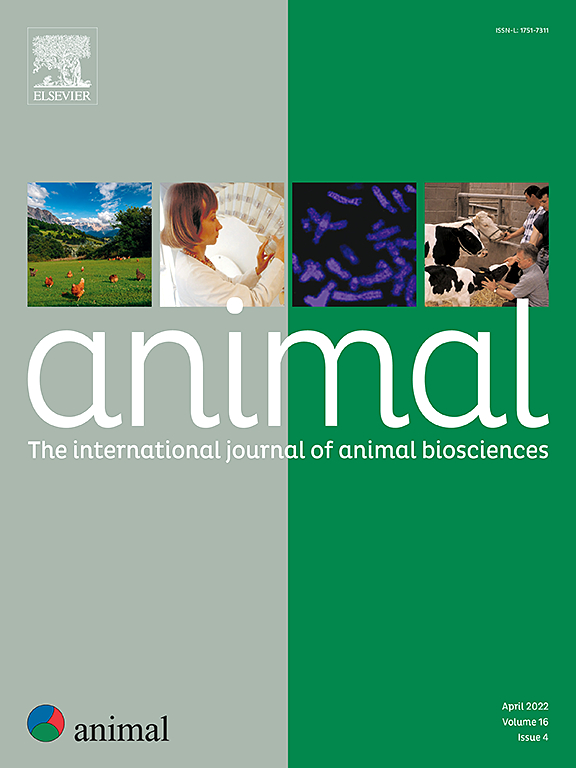动物委员会邀请评审:对养殖昆虫微生物群的功能理解的需要和途径
IF 4.2
2区 农林科学
Q1 AGRICULTURE, DAIRY & ANIMAL SCIENCE
引用次数: 0
摘要
在过去的二十年里,对工业生产的昆虫物种的研究快速增长,恰逢DNA测序的速度和可负担性取得突破。这使得研究人员能够快速生成与养殖昆虫相关的微生物群落数据,特别是两种基础生产物种的肠道细菌:黑兵蝇(BSF, Hermetia illucens)和黄粉虫(Tenebrio molitor)。与这些物种相关的最普遍和最丰富的微生物的图片迅速成为人们关注的焦点。在极端或具有挑战性的饲养条件下,已经提出了特定的微生物功能,但在实际生产条件下,微生物组对昆虫饲养的贡献知之甚少。人们对养殖昆虫的微生物群落如何产生、维持和响应刺激而变化的理解有限。对于一些看似基本的问题也是如此:与昆虫相关的微生物对宿主有什么作用?哪个(如果有的话)分类群对健康的昆虫是必不可少的?这并不是对现有研究的批评;事实上,这些问题并不简单。回答这些问题需要有针对性的研究方法来测试关于养殖昆虫微生物群功能的特定假设。本综述旨在通过批判性地评估研究这些微生物组的常见和新兴策略以及微生物组对BSF和粉虫的功能作用的现有知识缺口,重新校准知识状态。总的来说,很明显,微生物是这两种养殖昆虫生态的内在组成部分。微生物和昆虫之间的相互作用是广泛的,尽管微生物群落的组成在很大程度上取决于环境条件。迄今为止,尚不清楚分类变化如何对应功能变化,以及这种变化在多大程度上影响昆虫生理学。例如,当粉虫被喂食塑料时,它们的微生物组在微生物组成上发生了重大变化。据推测,这些变化增加了粉虫及其微生物群降解塑料的能力,但这种功能上的变化很难用现有的工具来最终证明。此外,文献分析表明,在分类上不同的微生物群落可能提供类似的功能益处,例如BSF幼虫的木质纤维素分解。因此,本文旨在批判性地评估有关养殖昆虫微生物组功能分析的最新进展,以及如何最好地应用现有的实验方法来确定微生物功能与昆虫生理之间的联系,从而提高养殖昆虫产业的效率和可持续性。本文章由计算机程序翻译,如有差异,请以英文原文为准。
Animal board invited review: The need for, and the path towards, a functional understanding of the farmed insect microbiome
The rapid growth of research on industrially produced insect species over the past two decades has coincided with breakthroughs in the speed and affordability of DNA sequencing. This has allowed researchers to rapidly generate data on the microbial communities associated with farmed insects, especially the gut-residing bacteria of the two cornerstone production species: black soldier fly (BSF, Hermetia illucens) and yellow mealworm (Tenebrio molitor). A picture of the most prevalent and abundant microbes associated with these species has rapidly come into focus. Specific microbial functions have been suggested under extreme or challenging rearing settings, but less is known about the contributions of the microbiome to insect rearing under realistic production conditions. There is limited understanding of how microbial communities of farmed insects arise, are maintained, and change in response to stimuli. Likewise for seemingly basic questions: what functions do insect-associated microbes perform for the host? Which (if any) taxa are essential for healthy insects? This is not intended as a criticism of existing research; indeed, these questions turn out not to be simple. Answering them requires targeted research approaches testing specific hypotheses about farmed insect microbiome function. This review aims to recalibrate the state of knowledge by critically assessing common and emerging strategies to study these microbiomes and existing knowledge gaps about the functional role of the microbiome for BSF and mealworm. Overall, it is clear that microbes are an intrinsic part of the ecology of these two farmed insects. Reciprocal interactions between microbes and insects are extensive, though microbiome community composition depends to a large extent on environmental conditions. To date, it remains unclear how taxonomical shifts correspond to functional shifts and to what extent such changes impact insect physiology. For example, when mealworms are fed plastics, their microbiomes undergo significant changes in microbial composition. These changes are presumed to increase the ability of mealworms and their microbiota to degrade plastic, but this change in function is hard to conclusively demonstrate with current tools. Furthermore, analysis of the literature shows that taxonomically disparate microbial communities may provide similar functional benefits, e.g. lignocellulose breakdown in BSF larvae. This review therefore aims to critically assess the state of the art with regard to functional analysis of the farmed insect microbiome and how available experimental methods can be best applied to identify links between microbial functions and insect physiology and improve the efficiency and sustainability of the farmed insect industry.
求助全文
通过发布文献求助,成功后即可免费获取论文全文。
去求助
来源期刊

Animal
农林科学-奶制品与动物科学
CiteScore
7.50
自引率
2.80%
发文量
246
审稿时长
3 months
期刊介绍:
Editorial board
animal attracts the best research in animal biology and animal systems from across the spectrum of the agricultural, biomedical, and environmental sciences. It is the central element in an exciting collaboration between the British Society of Animal Science (BSAS), Institut National de la Recherche Agronomique (INRA) and the European Federation of Animal Science (EAAP) and represents a merging of three scientific journals: Animal Science; Animal Research; Reproduction, Nutrition, Development. animal publishes original cutting-edge research, ''hot'' topics and horizon-scanning reviews on animal-related aspects of the life sciences at the molecular, cellular, organ, whole animal and production system levels. The main subject areas include: breeding and genetics; nutrition; physiology and functional biology of systems; behaviour, health and welfare; farming systems, environmental impact and climate change; product quality, human health and well-being. Animal models and papers dealing with the integration of research between these topics and their impact on the environment and people are particularly welcome.
 求助内容:
求助内容: 应助结果提醒方式:
应助结果提醒方式:


